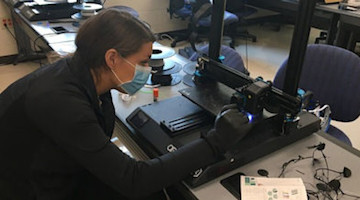As I am writing these words, I’ve just attended a White House summit (remotely, of course) on “A National Dialogue on Re-Opening Our Schools.” By the time you read this, there will surely be more clarity on whether, how, and when schools will re-open across the country; how many states will remain in a remote learning environment; and how many will have some sort of hybrid model in place. It’s safe to say that the opinion of the experts on the emotional and physical well-being of our nation’s young people is that schools must safely re-open this fall.
Ask any teacher, student, or parent of a student about how the remote teaching and learning experience progressed during the spring this year, and you’re likely to hear that a lack of consistency in class time, content delivery, and broadband access coupled with social concerns like lack of access to meals and a social safety net all appeared as serious issues.
Having personally worked from home with my wife, a high school art teacher, I was able to observe the challenges she faced in using Zoom, Google Classroom, etc. to teach a highly tactile curriculum to students who were disengaged from their learning environment.
Pediatricians and federal, state, and local education policymakers agree that all students – and especially very young students – are at risk of falling behind and potentially never catching up to their typical age group if schools are not able to stay consistently open. That can potentially have significant workforce impact five to 10 years from now or even longer.
In speaking with our educator colleagues around the country, we are beginning to see enrollments increase at many state and local community college systems as parents and students opt for a less-expensive, closer-to-home option. This is due to a lack of confidence in colleges and universities being the best investment at this time, since they could potentially close again and revert to an online, distance-learning model.
For families of graduating high school seniors who plan on attending college this fall, the smart money is on a community college education. It’s the safe option with the least impact on student loan debt.
High school career and technical education (CTE) and community college programs that teach CNC machining, mechatronics, and welding that reopen this fall will do so by limiting the number of teachers and students who can be in a lab at the same time and implementing strict hygiene, masking, and social distancing guidelines. We know of a few schools in the western United States and in Wisconsin who are using an image of a cow as the distance of measure on their social distancing signage. It’s a good tactic for lightening the mood while still getting the point across effectively.
Education programs that teach to industry-recognized standards and credentials are very hands-on. There is a portion of the curriculum that can be delivered by book and online, but students need to experience machine controls, robotic teach pendants, and other technologies with their hands.
If there is one thing that this pandemic has shown us, it’s that as a nation, we’ve been sorely deficient in adopting technologies that deliver on the promise of the manufacturing technology classroom of the future. Building a stable, 5G infrastructure across the entire United States will support students learning in remote locations. Additionally, this would enable new education technologies like augmented reality (AR) and virtual reality (VR) to become ubiquitous, not only in the classroom, but in the tools and technologies that our industry’s technicians need to have in their hands and on their screens as well.
AMT is working on two projects that will assist our members in understanding where we see the future of education and workforce development trending. One project is the publishing of AMT’s Manufacturing Mandate 3.0. The other is defining six transformational technologies so our members, the manufacturing industry, and the U.S. education community can better understand these technologies and their importance. As a result, they will be better positioned to build the MT classroom of the future as well as a viable workforce for the future of manufacturing.






